Wisconsin II (BB-64)
1944-2006
The 30th state, admitted to the Union in 1848.
II
(BB-64: displacement 45,000 (standard), 57,540 (full load); length 887'3"; beam 108'3"; draft 28'11" (mean); speed 33 knots; complement 2,978 (maximum,1945); 1,515 (1988); armament 9 16-inch, 20 5-inch, 80 40 millimeter, 49 20 millimeter; class Iowa)
The second Wisconsin (BB-64) was laid down on 25 January 1941 at the Philadelphia [Pa.] Navy Yard; launched on 7 December 1943; sponsored by Mrs. Walter S. Goodland; and commissioned on 16 April 1944, Capt. Earl E. Stone in command.
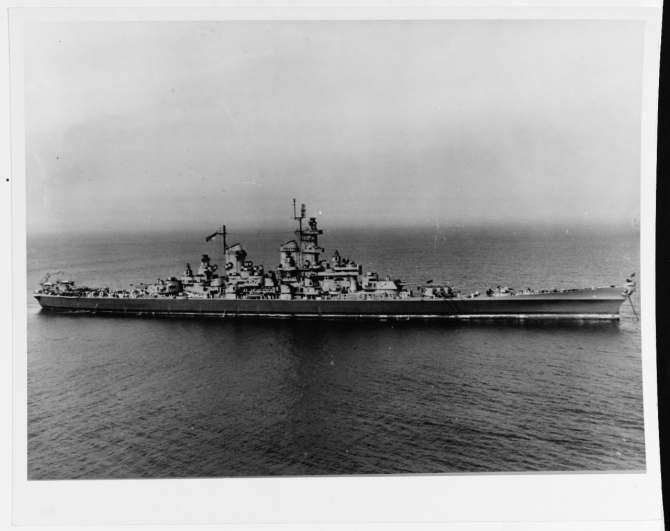
After her trials and initial training in the Delaware and Chesapeake bays, Wisconsin departed Norfolk, Va. on 4 July 1944, in concert with Winslow (DD-359), Simpson (DD-221), and Decatur (DD-341) bound for Trinidad, British West Indies. Arriving at Port of Spain, Trinidad, Wisconsin conducted shakedown exercises in the Gulf of Paria from 8-31 July. On 1 August Wisconsin departed Trinidad along with Decatur and Bainbridge (DD-246) en route to Philadelphia via Culebra, Puerto Rico. On 2 August Wisconsin conducted firing practice on the range at Culebra. On 5 August she anchored in the lower Delaware Bay. From 6-9 August the ship conducted further exercises and returned to the Philadelphia Navy Yard on 10 August. From 10 September through 23 September, Wisconsin remained moored in Philadelphia undergoing post-shakedown availability. On 24 September 1944 Wisconsin conducted full speed trials which she completed the next day, 25 September.
On 27 September 1944 the ship got underway for drone firing off the Delaware capes and upon completion joined Task Group (TG) 27.3 under Rear Adm. J.C. Jones, Commander Cruiser Division 17 with the light cruiser Pasadena (CL-65), and the destroyer escort Moore (DE-240), and the destroyers Collett (DD-730), Haynsworth (DD-700), Waldron (DD-699), and Charles S. Sperry (DD-697). The group transited the Panama Canal on 2-3 October and on 4 October Wisconsin conducted anti-aircraft gunnery exercises in the Gulf of Panama. Later that day, Wisconsin in concert with Pasadena, Moore, Collett, Haynsworth, Waldron, and Charles S. Sperry, departed for San Diego, Calif. En route Wisconsin conducted live-fire exercises and anchored in San Pedro Bay on 12 October. The battleship remained at anchor until 14 October when she got underway for Pearl Harbor, Territory of Hawaii in company with Pasadena, North Carolina (BB-55), Charles S. Sperry, Waldron, and Haynsworth. While underway to Hawaiian waters, the battleship again conducted gunnery exercises. On 20 October Wisconsin moored at Pearl Harbor. That same day she reported to Commander, Task Force (TF) 15 for training in accordance with her orders. On 24 October Wisconsin got underway for gunnery training exercises. From this date through 1 November the battleship conducted multiple main battery and anti-aircraft gunnery exercises. From her return to Pearl Harbor on 1 November through 29 November, Wisconsin remained at Pearl Harbor. On 25 November, Rear Adm. Edward W. Hanson, Commander Battleship Division (BatDiv) 9 broke his flag in Wisconsin.
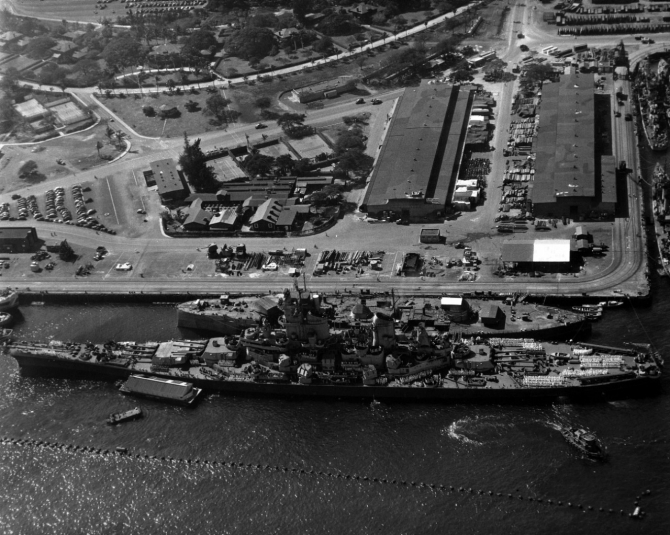
9On 29 November 1944, Task Unit (TU) 12.5.9, consisting of Wisconsin and the destroyers Frazier (DD-607) and Meade (DD-602) was constituted under Rear Adm. Hanson. Wisconsin, along with Frazier and Meade departed Pearl Harbor on 30 November to conduct gunnery exercises in Hawaiian waters. Upon completing those exercises on 1 December, TU 12.5.9 departed the Hawaiian Islands bound for Ulithi, Caroline Islands. Having conducted gunnery exercises while underway, TU 12.5.9 anchored at Ulithi on 9 December. After a day at anchor Wisconsin departed Ulithi on 11 December with BatDiv 7 in TG 34 under Rear Adm. Oscar C. Badger, Commander, BatDiv 7, TG 34.5 on board Iowa (BB-61) for gunnery exercises. Later that day Wisconsin joined TG 38.2 under Rear Adm. Gerald F. Bogan, Commander, TG 38.2 on board Lexington (CV-16), Vice Adm. John S. McCain TF 38 on board Hancock (CV-19), and Adm. William F. Halsey, Jr., Commander, Third Fleet, on board New Jersey (BB-62) with TG 38.2.
Wisconsin had arrived at a time when the reconquest of the Philippines was well underway. As a part of that movement, the planners had envisioned landings on the southwest coast of Mindoro, south of Luzon as a prelude to landings on Luzon itself. From that point American forces threatened Japanese shipping lanes through the South China Sea. The day before the amphibious forces assaulted Mindoro, the Third Fleet's Fast Carrier Task Force 38, supported in part by Wisconsin, rendered Japanese facilities at Manila largely useless against the landings on the island. Between 14 and 16 December, TF 38's naval aviators secured complete tactical surprise and quickly won complete mastery of the air and sank or destroyed 27 Japanese vessels; damaged 60 more; destroyed 269 planes; and bombed miscellaneous ground installations.
The next day, however, the weather turned for Halsey's sailors. A furious typhoon struck the Third Fleet, catching many ships refueling and with little ballast in their nearly dry bunkers. Three destroyers, Hull (DD-350), Monaghan (DD-354), and Spence (DD-512), capsized and sank. Proving her seaworthiness, Wisconsin escaped the storm unscathed. After the weather abated on 19 December 1944, she refueled and later conducted gunnery exercises on 24 December, anchoring at Ulithi when completed. She remained at anchor from 25 through 29 December. On 30 December the ship got underway as part of TG 38.2 and conducted gunnery training.
On 1 January 1945 Wisconsin was detached from TG 38.2 and joined TF 34 for exercises under Vice Adm. Willis A. Lee on board South Dakota (BB-57). On 2 January Wisconsin spent the day fueling the destroyers Lewis Hancock (DD-675) and Hunt (DD-674) and taking fuel from the oiler Taluga (AO-62). Wisconsin, armed with heavy antiaircraft batteries, performed escort duty for TF 38's fast carriers during air strikes against Formosa, Luzon, and the Nansei Shoto, to neutralize Japanese forces there and to cover the unfolding Lingayen Gulf operations. Those strikes, lasting from 3 to 22 January 1945, included a thrust into the South China Sea, in the hope that major units of the Japanese Navy could be drawn into battle. On 5 January, Wisconsin refueled the destroyers Owen (DD-536) and Miller (DD-535) and took on fuel from Neches (AO-47). Two days later, on 7 January, the battleship fueled the destroyers Waldron and Ault (DD-698) and on 8 January again fueled Owen and Ault and re-fueled from Neches. On 9 January Wisconsin detected an underwater contact. Sperry and Haynsworth were dispatched but without results. On 10-11 January she steamed southwesterly in the South China Sea towards French Indochina. On the latter day, the battleship fueled Ault, Halsey Powell (DD-686), and Franks (DD-554) en route.
Air strikes between Saigon and Camranh Bay, Indochina on 12 January 1945 resulted in severe losses for the enemy. That same day Wisconsin was directed to bombard Camranh Bay if targets were available, but none were present and she returned to the task force. TF 38's warplanes did sink 41 ships and damaged 31 in two convoys they encountered. In addition they heavily damaged docks, storage areas, and aircraft facilities. After a few days of poor weather, Wisconsin began a run in towards a rendezvous for launching attacks against Hong Kong and Formosa on 15 January, but weather negatively impacted strikes over the following days. On 20 January the ship detected numerous incoming enemy aircraft and general quarters was sounded. The anti-aircraft batteries opened fire, but there were no hits observed. After refueling destroyers on 21 and 22 January, Wisconsin took on fuel from Atascosa (AO-66) on 23 January. On 24 January the ship commenced maneuvering for an anti-aircraft gunnery exercise and on the next day spent the morning in battle line maneuvers and concluded the exercise in the afternoon. Early on 26 January, Wisconsin commenced main and secondary battery gunnery exercises and in the afternoon she returned to and anchored at Ulithi. She remained anchored there through 1 February.
Wisconsin conducted anti-aircraft gunnery exercises on 2 February 1945 and returned to anchor at Berth 37 at Ulithi where she remained until 9 February. On 10 February she sortied from Ulithi with BatDiv 9 and Cruiser Division (CruDiv) 6 and conducted joint surface firing exercises with Missouri (BB-63) at a towed sled with main and secondary batteries. Later that day Wisconsin joined TG 58.2 under Rear Adm. Ralph Davison on board Lexington. The task group was cruising in the general direction of Tokyo, Japan and exercising en route as part of TF 58 under Vice Adm. Marc A. Mitscher commanding on board Bunker Hill (CV-17). On 11 February TU 58.2.2 was formed under Rear Adm. Hanson, on board Wisconsin, and the ship conducted anti-aircraft gunnery exercises. Upon completing the exercises the ship rejoined TG 58.2. On 13 February TF 59 was formed under Vice Adm. Lee on board South Dakota with Wisconsin as a constituent member. Later that day, she took on fuel from Cimarron (AO-22) and then subsequently fueled Marshall (DD-676) and Lewis Hancock. On 15 February the battleship fueled Hickox (DD-673), Uhlmann (DD-687), Hunt, Stockham (DD-683), Marshall, and Twining (DD-540) in preparation for a run in towards Tokyo.
On 16 February 1945, the task force approached the Japanese coast under cover of adverse weather conditions and achieved complete tactical surprise. Wisconsin was cruising 120 miles southeast of Tokyo while carrier planes launched for strikes against the area. The ship remained in the area the next day though poor weather forced the cancellation of additional airstrikes later in the day. On 18 February the battleship and her escorts were en route to Iwo Jima to provide direct support for the landings slated to take place on that island (Operation Detachment). Wisconsin refueled Colahan (DD-658), Stockham, Halsey Powell, Yarnall (DD-541), Wedderburn (DD-684), and Marshall while underway. On 19 February, Wisconsin was off Iwo Jima while carriers launched covering strikes in support of the invasion. There was a reported enemy submarine contact, but that proved negative. The ship did go to general quarters when notified of incoming enemy aircraft, but negative contact resulted in securing from same. The next day, 20 February, Wisconsin retired southwest from Iwo Jima and refueled from Aucilla (AO-56) Capt. John W. Roper came on board from Buchanan (DD-484) as relief for Capt. Earl E. Stone as Wisconsin’s commanding officer.
On 21 February 1945 Wisconsin returned to the waters off Iwo Jima and was required to engage incoming enemy aircraft with her 5-inch/38 cal. batteries. Remaining off Iwo Jima on 22 February, the battleship refueled Mertz (DD-691) and Monssen (DD-798) and on the next, 23 February, took on fuel from Merrimack (AO-37) and refueled Colahan, Hunt, and Remey (DD-688) in preparation for a run in towards Tokyo that began later that day. While still on that run on 24 February, Wisconsin fueled Colahan, Tingey (DD-539), Hickox, Lewis Hancock, and Marshall. On 25 February, two strikes were launched, but the remaining sorties were cancelled because of adverse weather. Having spent 26-27 February cruising, Wisconsin spent the morning of 28 February fueling Stockham, Hunt, Wedderburn, and Twining in preparation for a high-speed run in towards Okinawa that commenced late that afternoon.
On 1 March 1945, Wisconsin was in company with TF 58 under Vice Adm. Mitscher. Reconnaissance planes flew over Okinawa, taking intelligence photographs to be used in planning the assault on that island. The next day, 2 March, while cruisers from TF 58 shelled Okino Daito Shima in training for the Okinawa landings, Wisconsin retired to Ulithi for replenishment. En route she refueled Owen, Tingey, Miller, and The Sullivans (DD-537) and conducted anti-aircraft gunnery training exercises. The ship again conducted refueling operations for Hickox and Lewis Hancock on 3 March, then later that day began tactical maneuvers with the other fast battleships and then the cruiser group of TF 59 (59.6) conducted a simulated light force attack against the battleship group (59.7). While still en route to Ulithi on 4 March, Wisconsin went to general quarters for simulated attack by light forces at night. Having secured from general quarters the ship then conducted tactical maneuvers and commenced main battery and secondary battery firing exercises at towed sleds. On 5 March as the she approached Ulithi, Wisconsin again conducted morning gunnery exercises then anchored at Ulithi in the afternoon. She remained at anchor through 12 March though the ship was assigned to TG 58.4 and ordered to sortie with battleships in TF 59. On 13 March, in preparation for combat operations, Wisconsin shifted to the firing berth and conducted anti-aircraft gunnery training.
Wisconsin's TG 59.7 as part of Vice Adm. Lee’s TF 59 stood out of Ulithi on 14 March 1945, bound for Japan. The mission of that group was to eliminate airborne resistance from the Japanese home islands to American forces off Okinawa. On 16 March Wisconsin fueled from Chicopee (AO-34) and conducted maneuvers and drills in preparation for combat operations. On 17 March she fueled McGowan (DD-678) and Hailey (DD-556) and on the next day, 18 March, Wisconsin was off Kyushu while carrier planes made strikes against Kyushu, Shikoku, and southwestern Honshu. While on station Wisconsin engaged incoming enemy aircraft with anti-aircraft fire. Still of Kyushu on 19 March the battleship continued to operate as part of the task force while aircraft raided targets in Japan. On 20 March Wisconsin maneuvered when there were reports of an enemy submarine in the area, but there was negative contact. The ship also engaged incoming enemy aircraft with anti-aircraft fire. The ship retired towards the fueling area and remained ready to respond in the event of the approach of enemy aircraft. Wisconsin remained in the fueling area on 22 March and took on fuel from Cache (AO-67). On 23 March she was en route to Okinawa and maneuvered when an enemy submarine was reported. As there was negative contact, the battleship fueled Melvin (DD-680). Though there were reports of approaching enemy aircraft, there was no contact. On 24 March Wisconsin made preparations to fire shore bombardments of southeastern Okinawa in company with other fast battleships. She trained her 16-inch main battery on targets ashore. Together with the other battleships of the task force, she pounded Japanese positions and installations in preparation for the landings. The ships maneuvered accordingly and Wisconsin later took up station in anti-aircraft cruising disposition. On 25 March the ship remained off Okinawa and while air strikes launched against Miyako, Amami, and Okinawa, she was ordered to leave TG 58.1 and with New Jersey, Missouri, and five destroyers reported to TG 58.4. On 26-27 March the ship continued to maneuver off Okinawa and while prepared to respond to enemy air attack, none came into range. The ship then proceeded to the fueling area. While at the fueling rendezvous on 28 March, Wisconsin took on fuel from Nantahala (AO-60) and then fueled Mertz and Remey. She then passed six miles south of Minami Daito Shima and then turned northwards to rendezvous with other elements of TF 58 amidst reports that a Japanese fleet may be sortieing south from the Inland Sea. With Wisconsin now southeast of Kyushu, the Japanese returned to the Inland Sea and TF 58 was ordered to return to operating off Okinawa. While en route the battleship and other ships in the formation engaged enemy aircraft. Unfortunately, two intercepting American planes were mistakenly shot down. On 30 March while off Okinawa, Wisconsin executed her barrage jamming plan while engaging enemy aircraft. The battleship also fueled the destroyers Monssen, Trathen (DD-530), Benham (DD-796), and Colahan. The next day, while still off Okinawa, Wisconsin fueled Mertz, McGowan, and Monssen while task force combat air patrols (CAP) engaged enemy aircraft.
On 1 April 1945 Wisconsin continued to operate off Okinawa providing direct support for the Amphibious Force’s landings (Operation Iceberg). In addition the ship fueled Colahan, McGowan, Mertz, and Monssen. The next day, 2 April, saw the battleship continue her operations off Okinawa while CAP provided overhead cover. When the carriers from the task group recovered their aircraft, TG 58.4 detached from TF 58 and proceeded to the fueling rendezvous to the southeast. On 3 April, the approach of a typhoon with increasing winds and heavy seas, forced a change of course for an alternate fueling location which was found to the south southwest. Wisconsin then began fueling from Merrimack. This effort was cut short by darkness. The next day, 4 April, the ship cruised in the fueling area. While awaiting her refueling opportunity after the carriers, Wisconsin along with accompanying battleships and cruisers conducted anti-aircraft practice. The battleship then fueled from Escalante (AO-70). When fueling was complete TG 58.4 reformed cruising disposition and set course west for operating area off Sakishima Gunto in order to strike while TF 57 was absent. On 5 April carrier planes struck Sakishima Gunto while Wisconsin fueled McGowan. The task force’s screen engaged some floating Japanese mines. The task group was then ordered to return to the fueling area so the carriers could complete rearming. While the carriers rearmed on 6 April, Wisconsin fueled from Aucilla and conducted anti-aircraft exercises. On 7 April the ship was again off Okinawa in company with TF 58 when a report was received of a Japanese force consisting of one battleship, two light cruisers, and eight destroyers approaching Okinawa (Operation Ten-Go). The carriers launched strikes which resulted in the sinking of six ships, including the battleship Yamato, the light cruiser Yahagi, and four destroyers. While that action took place, the ships of the task group endured repeated air attacks off Okinawa. CAP knocked down 15 enemy planes, and ships' gunfire accounted for another three, but not before one kamikaze penetrated the combat air patrol and screen to crash the fleet carrier Hancock (CV-19). Wisconsin spent 8-9 April continuing to maneuver off Okinawa and remaining ready to engage enemy aircraft. On 10 April the battleship spent the day in the fueling rendezvous east and southeast of Rasa Island.
On 11 April 1945, the Japanese renewed kamikaze attacks. Only drastic maneuvers and heavy barrages of gunfire saved the task force. None of the enemy pilots achieved any direct hits, although near misses, close aboard, managed to cause some minor damage. CAP downed 17 planes, and ships' gunfire accounted for an even dozen. The next day, 151 enemy aircraft attacked TF 58, but Wisconsin, bristling with 5-inch, 40-millimeter and 20-millimeter guns, together with other units of the screens for the vital carriers, kept the enemy at bay or destroyed him before he could reach his targets. Over the ensuing days, American task force planes hit Japanese facilities and installations on the Japanese home islands and provided air support for the invading American ground forces on Okinawa. Kamikazes, redoubling their efforts, managed to crash into three carriers on successive days, 16-18 April; Intrepid (CV-11), Bunker Hill, and Enterprise (CV-6). On 19 April, Wisconsin stood off southeastern Okinawa and then set a course for the fueling rendezvous where she spent 20 April fueling from Cowanesque (AO-79). With fueling and replenishment completed, the ship along with TG 58.4 departed for the operating area off Okinawa. From 21-23 April Wisconsin maintained cruising disposition and remained prepared to provide the anti-aircraft screen for the task force carriers launching aircraft in support of American ground forces on Okinawa. Later on 23 April Wisconsin withdrew to the fueling rendezvous. After fueling from Neches on 24 April and being joined by Iowa and Shangri-La (CV-38), the ship conducted anti-aircraft training and then remained at the fueling area for another day. Wisconsin was back operating off Okinawa on 26 April. That same day, while carrier aircraft continued close air support (CAS) missions on Okinawa, Rear Adm. Hanson was relieved by Rear Adm. Louis E. Denfield as Commander, BatDiv 9 on board Wisconsin. On 27 April she fueled Monssen and McNair (DD-679) and then retired to the fueling rendezvous. Having fueled from Tomahawk (AO-88) on 28 April, the battleship conducted anti-aircraft training, firing at a drone with automatic weapons. The ship, along with TG 58.4 departed for the operating area off Okinawa. From 29 April though 1 May, Wisconsin operated off Okinawa as carrier aircraft provided CAS. Having fueled Monssen and Black (DD-666) on 30 April, Wisconsin departed for the fueling rendezvous on 1 May.
At the fueling rendezvous on 2 May 1945, the battleship fueled from Aucilla and transferred 11 patients to the hospital ship Bountiful (AH-9) before departing to return to her operating area off Okinawa. She remained on station while carrier aircraft conducted CAS missions from 2 through 6 May, when she fueled Norman Scott (DD-690) and Benham and later withdrew to the fueling rendezvous. She spent 7 May fueling from Manatee (AO-58), receiving ammunition from Mauna Loa (AE-8), and conducting anti-aircraft training before returning to Okinawa where she remained on station until 11 May. In the evening on the last day, Wisconsin departed her station. En route to Ulithi from 11-14 May, she fueled Uhlmann and Norman Scott, conducted ant-aircraft gunnery training and tactical maneuvers while underway. Having arrived on 14 May, Wisconsin spent 15-23 May at Ulithi replenishing stores and ammunition. On 24 May the ship got underway from Ulithi to sortie with TG 58.4. While underway the ship’s crew conducted anti-aircraft gunnery training and a fire drill. On 25 May, while en route to a fueling rendezvous in the vicinity of Okino Daito Shima, Wisconsin was part of TU 58.4.2 which also consisted of Iowa, Guam (CB-2), Alaska (CB-1), and a destroyer screen. While underway the ship conducted tactical maneuvers and main battery gunnery firing. On 26 May she fueled Monssen, Norman Scott, and Colahan and conducted anti-aircraft training. Having arrived at the fueling rendezvous by 27 May, Wisconsin fueled from Lackawanna (AO-40). On 28 May the TG’s designator was changed to 38.4 and later that day Missouri and McNair joined the task group southeast of Okinawa. While underway on 29 May McNair and Wadleigh (DD-689) fueled from the ship. Over the next two days, 29-30 May, Wisconsin fueled Cushing (DD-797), Colahan, and Norman Scott.
On 1 June 1945 Wisconsin was in the fueling area in company with TG 38.4 under the command of Rear Adm. Arthur W. Radford in Yorktown (CV-10). The ship fueled from Mascoma (AO-83) and over the next two days, she fueled Norman Scott, Remey, Monssen, and Hailey (DD-556). By 4 June a typhoon was swirling through the Fleet. Wisconsin rode out the storm unscathed, but three cruisers, two carriers, and a destroyer suffered serious damage. Offensive operations were resumed on 8 June. On that day Wisconsin launched her two floatplanes and one rescued a downed pilot from Shangri-La. The next day, 9 June, Wisconsin again launched her floatplanes in conjunction with a task group air strike on Minani Daito Shima. The planes retuned without having to conduct a rescue. Wisconsin spent 10 June east of Okina Daito Shima fueling Benham and Remey in the morning and then conducting anti-aircraft training in the afternoon before fueling Colahan. The next day, 11 June, she was en route to Leyte where she put into Leyte Gulf and dropped anchor on 13 June for repairs and replenishment.
Three weeks later, on 1 July 1945, Wisconsin and her consorts departed Leyte Gulf for Japanese home waters for carrier air strikes. On 8 July the ship arrived at the fueling rendezvous where she fueled Mertz and Colahan before taking on fuel from Sebec (AO-87). The next day, 9 July, Wisconsin was en route to the operating area east of Tokyo. While underway she fueled Smalley (DD-564), McNair, and Frank Knox (DD-742) before beginning her high speed run in towards the dawn launch position for the task force’s aircraft. Launching from east of Honshu on 10 July, carrier planes from TF 38 destroyed 72 enemy aircraft on the ground and smashed industrial sites in the Tokyo area. Over the next four days, 11-14 July, Wisconsin conducted refueling operations and anti-aircraft drills with impunity as the task force maneuvered off Japan. On 15 July Wisconsin, in conjunction with Iowa, Missouri, Atlanta (CL-104), Dayton (CL-105), and nine destroyers, bombarded the steel mills and oil refineries at Muroran, Hokkaido. On 16 July the ship fueled from Manatee then fueled the destroyers McGowan, and Mertz. The next day, 17 July, Wisconsin conducted a night bombardment in conjunction with Iowa, Missouri, Alabama (BB-60), North Carolina (BB-55), Atlanta, Dayton, and the nine destroyers. Together they wrecked the industrial facilities in the Hitachi Miro area, on the coast of Honshu, northeast of Tokyo. During that bombardment, the British battleship HMS King George V and two destroyers of the Eastern Fleet contributed their heavy shellfire. Having completed the bombardment just after midnight on 18 July the task group retired and was en route to the replenishment area on 19 July. While there Wisconsin fueled Frank Knox, Stockham, and Stoddard (DD-566).
At the replenishment area on 20 July 1945 the battleship fueled from Lackawanna and commenced rearming with 16-inch ammunition from Shasta (AE-6). She remained at the replenishment area until 22 July and took on additional ammunition from Vesuvius (AE-15). Upon completion of this resupply the task force departed the fueling area en route to its operating area southeast of Kyushu. While underway on 23 July Wisconsin fueled Twining, Cushing, and Benham and conducted anti-aircraft training.
On 24 and 25 July 1945, while American carrier planes visited the Inland Sea region blasting enemy sites on Honshu, Kyushu, and Shikoku, Wisconsin took up station off Kyushu and fueled Uhlmann and Smalley. On 26 July the battleship was at the fueling rendezvous where she took on supplies from Alcoyne (AKA-7) and fueled from Lackawanna. She remained in the area on 27 July and conducted anti-aircraft training before departing for her operating area southeast of Shikoku. On 28 July she returned to operating east of Kyushu while carriers launched strikes against Japanese ships and installations on the Inland Sea. On 29 July Wisconsin moved to an operating area south of Honshu and fueled Colahan, Wedderburn, and McGowan. While still south of Honshu on 30 July, Wisconsin stayed on station as carriers continued to launch air strikes against the Tokyo-Nagoya area. The end of the month saw the battleship again move to the replenishment rendezvous where she fueled from Platte (AO-24). She remained there on 1 August.
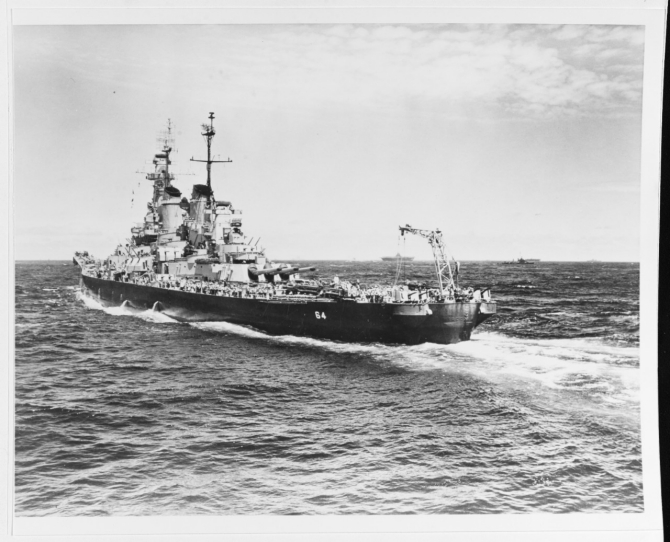
Wisconsin departed the replenishment area and was cruising west of Iwo Jima on 2 August 1945. The next day, 3 August, she fueled from Cimarron and then spent the next few days cruising to and from the replenishment area refueling her accompanying destroyers and conducting anti-aircraft training. On 8 August she was operating southeast of Hokkaido, but the air strikes were cancelled due to poor weather. On 9 August the ship was operating off Honshu while strikes were launched against northern Honshu and Hokkaido. She remained off Honshu on 10 August fueling Remey and McGowan and then retired to the replenishment area later in the day. While at the replenishment rendezvous on 11 August, Wisconsin fueled Caperton (DD-650) and Wadleigh and fueled from Taluga. That same day, Rear Adm. Howard F. Kingman relieved Rear Adm. Denfield as Commander, BatDiv 9. On 12 August, Wisconsin cruised in the replenishment area awaiting developments and the next day, 13 August, moved to her operating area east of Honshu. On 14 August Wisconsin returned to the replenishment area and fueled Stockham and Taylor and then fueled from Sebec. On 15 August, as Wisconsin stood off Honshu, word of the Japanese surrender was received at 0805 together with messages cancelling all future air strikes. World War II was over.
Wisconsin, as part of the occupying force, arrived at Tokyo Bay on 5 September 1945, three days after the formal surrender occurred on board Missouri. During Wisconsin's brief career in World War II, she had steamed 105,831 miles since commissioning; had shot down three enemy planes; had claimed assists four times; and had fueled her screening destroyers on some 250 occasions.
Shifting subsequently to Okinawa, the battleship embarked homeward-bound veterans on 22 September, as part of the Magic Carpet operation staged to bring soldiers, sailors, and marines home from the battlefronts of the Pacific theater. Departing Okinawa on 23 September, Wisconsin reached Pearl Harbor on 4 October, remaining there for five days before she pushed on for the west coast on the last leg of her stateside-bound voyage. She reached San Francisco on 15 October.
Heading for the east coast of the United States soon after New Year’s Day 1946, Wisconsin transited the Panama Canal between 11 and 13 January, and reached Hampton Roads, Va., on 18 January. Following a cruise south to Guantánamo Bay, Cuba, the battleship entered the Norfolk Naval Shipyard for overhaul. After repairs and alterations that consumed the summer months, Wisconsin sailed for South American waters.
Over the weeks that ensued, the battleship visited Valparaiso, Chile, from 1 to 6 November 1946; Callao, Peru, from 9 to 13 November; Balboa, Canal Zone, from 16 to 20 November; and La Guajira, Venezuela, from 22 to 26 November, before returning to Norfolk on 2 December.
Wisconsin spent nearly all of 1947 as a training ship, taking naval reservists on two-week cruises throughout the year. Those voyages commenced at Bayonne, N.J., and saw visits conducted at Guantanamo Bay, Cuba, and the Panama Canal Zone. While underway at sea, the ship would perform various drills and exercises before the cruise would end where it had started, at Bayonne. During June and July of 1947, Wisconsin took Naval Academy midshipmen on cruises to northern European waters.
In January 1948, Wisconsin joined the Atlantic Reserve Fleet at Norfolk, for inactivation. Placed out of commission, in reserve, on 1 July 1948, Wisconsin was assigned to the Norfolk group of the Atlantic Reserve Fleet.
Her sojourn in “mothballs,” however, proved comparatively brief because of the North Korean invasion of South Korea on 25 June 1950. Wisconsin was recommissioned on 3 March 1951, Capt. Thomas Burrowes in command. After shakedown training, the recommissioned battleship conducted two midshipmen training cruises, taking the officers-to-be to Edinburgh, Scotland; Lisbon, Portugal; Halifax, Nova Scotia; New York City; and Guantánamo Bay, Cuba, before she returned to Norfolk.
Wisconsin departed Norfolk on 25 October 1951, bound for the Pacific. She transited the Panama Canal on 29 October and reached Yokosuka, Japan, on 21 November. There, she relieved New Jersey (BB-62) as flagship for Vice Adm. Harold M. Martin, Commander, Seventh Fleet.
On 26 November 1951, with Vice Adm. Martin and Rear Adm. Francis C. Denebrink, Commander, Service Force, Pacific, embarked, Wisconsin departed Yokosuka for Korean waters to support the fast carrier operations of TF 77. She left the company of the carrier force on 2 December and, screened by the destroyer Wiltsie (DD-716), provided gunfire support for the Republic of Korea (ROK) Corps in the Kasong-Kosong area. After disembarking Rear Adm. Denebrink on 3 December at Kangnung, the battleship resumed station on the Korean "bombline," providing gunfire support for the U.S. First Marine Division. Wisconsin's shellings accounted for a tank, two gun emplacements, and a building. She continued her gunfire support task for the 1st Marine Division and 1st ROK Corps through 6 December, accounting for enemy bunkers, artillery positions, and troop concentrations. On one occasion during that time, the battleship received a request for call-fire support and provided three starshells for the 1st ROK Corps, illuminating a communist attack that was consequently repulsed with considerable enemy casualties.
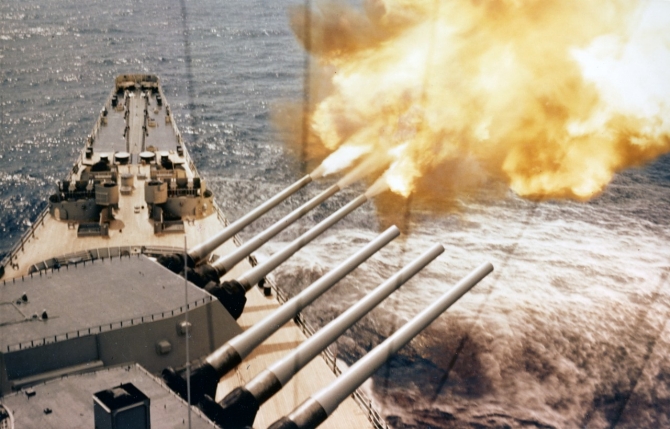
After being relieved on the gunline by the heavy cruiser St. Paul (CA-73) on 6 December 1951, Wisconsin retired only briefly from gunfire support duties. She resumed them, however, in the Kasong-Kosong area on 11 December, screened by Twining. The following day, 12 December, saw the embarkation in Wisconsin of Rear Adm. Harry R. Thurber, Commander, Battleship Division Two (BatDivTWO), who came on board via helicopter, incident to his inspection trip in the Far East.
The battleship continued naval gunfire support (NGFS) duties on the bombline, shelling enemy bunkers, command posts, artillery positions, and trench systems through 14 December 1951. She departed the bombline on that day to render special gunfire support duties in the Kojo area, blasting coastal targets in support of United Nations (UN) troops ashore. That same day, she returned to the Kasong-Kosong area. On 15 December she disembarked Rear Adm. Thurber by helicopter. The next day, Wisconsin departed Korean waters, heading for Sasebo to rearm.
Returning to the combat zone on 17 December 1951, Wisconsin embarked U.S. Senator Homer S. Ferguson (R., Michigan) on 18 December. That day, the battleship supported the 11th ROK division with night illumination fire that enabled the ROK troops to repulse a communist assault with heavy enemy casualties. Departing the bombline on the 19th, the battleship later that day transferred her distinguished passenger, Senator Ferguson, by helicopter to the carrier Valley Forge (CV-45).
Wisconsin next participated in a coordinated air-surface bombardment of Wonsan to neutralize preselected targets. She shifted her bombardment station to the western end of Wonsan harbor, hitting boats and small craft in the inner swept channel during the afternoon. Such activities helped to forestall any communist attempts to assault the friendly-held islands in the Wonsan area. Wisconsin then made an anti-boat sweep to the north, utilizing her 5-inch batteries on suspected boat concentrations. She then provided gunfire support to UN troops operating at the bombline until three days before Christmas 1951. She then rejoined the carrier task force.
On 28 December 1951 Francis Cardinal Spellman, on a Korean tour over the Christmas holidays, visited the ship, coming on board by helicopter to celebrate Mass for the Catholic members of the crew. The distinguished prelate departed the ship by helicopter off Pohang. Three days later, on the last day of the year, Wisconsin put into Yokosuka.
Wisconsin departed that Japanese port on 8 January 1952 and headed for Korean waters once more. She reached Pusan the following day and entertained the President of South Korea, Syngman Rhee, and his wife, on the 10th. President and Mrs. Rhee received full military honors as they came on board, and he reciprocated by awarding Vice Adm. Martin the ROK Order of the Military Merit.
Wisconsin returned to the bombline on 11 January 1952 and, over the ensuing days, delivered heavy gunfire support for the First Marine Division and the First ROK Corps. As before, her primary targets were command posts, shelters, bunkers, troop concentrations, and mortar positions. As before, she stood ready to deliver call-fire support as needed. One such occasion occurred on 14 January when she shelled enemy troops in the open at the request of the ROK First Corps. Rearming at Sasebo and once more joining TF 77 off the coast of Korea soon thereafter, Wisconsin resumed support at the bombline on 23 January. Three days later, she shifted once more to the Kojo region, to participate in a coordinated air and gun strike. That same day, the battleship returned to the bombline and shelled the command post and communications center for the 15th North Korean Division during call-fire missions for the First Marine Division.

Returning to Wonsan at the end of January 1952, Wisconsin bombarded enemy guns at Hodo Pando before she was rearmed at Sasebo. The battleship rejoined TF 77 on 2 February and, the next day, blasted railway buildings and marshalling yards at Hodo Pando and Kojo before rejoining TF 77. After replenishment at Yokosuka a few days later, she returned to the Kosong area and resumed gunfire support. During that time, she destroyed railway bridges and a small shipyard besides conducting call fire missions on enemy command posts, bunkers, and personnel shelters, making numerous cuts on enemy trench lines in the process.
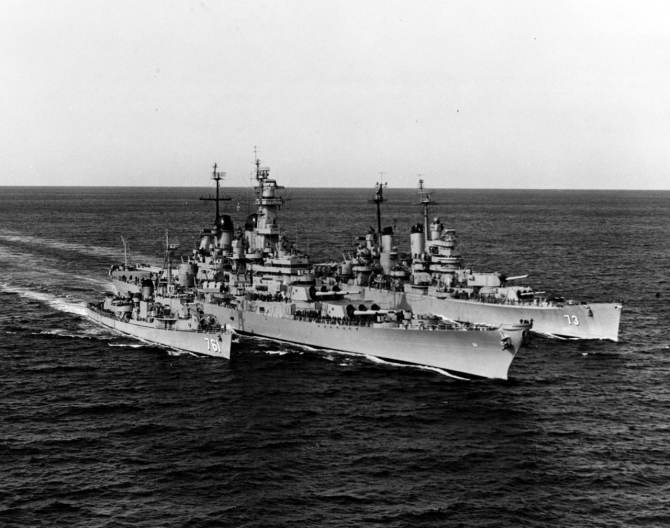
On 25 February 1952, Wisconsin arrived at Pusan where Vice Adm. Shon, the ROK Chief of Naval Operations; U.S. Ambassador John J. Muccio; and Rear Adm. Scott-Montcrief, Royal Navy, Commander, Task Group 95.12, visited the battleship. Departing the South Korean port the following day, Wisconsin reached Yokosuka on 2 March. A week later, she shifted to Sasebo to prepare to return to Korean waters.
Wisconsin arrived off Songjin, Korea, on 15 March 1952 and concentrated her gunfire on enemy railway transport. Early that morning, she destroyed a communist troop train trapped outside of a destroyed tunnel. That afternoon, she received the first direct hit in her history, when one of four shells from a communist 155-millimeter gun battery struck the shield of a starboard 40 millimeter mount. Although little material damage resulted, three men were injured. Wisconsin responded by shelling that battery and destroying it with a 16-inch salvo before continuing her mission. After lending a hand to support once more the First Marine Division with her heavy rifles, the battleship returned to Japan on 19 March.
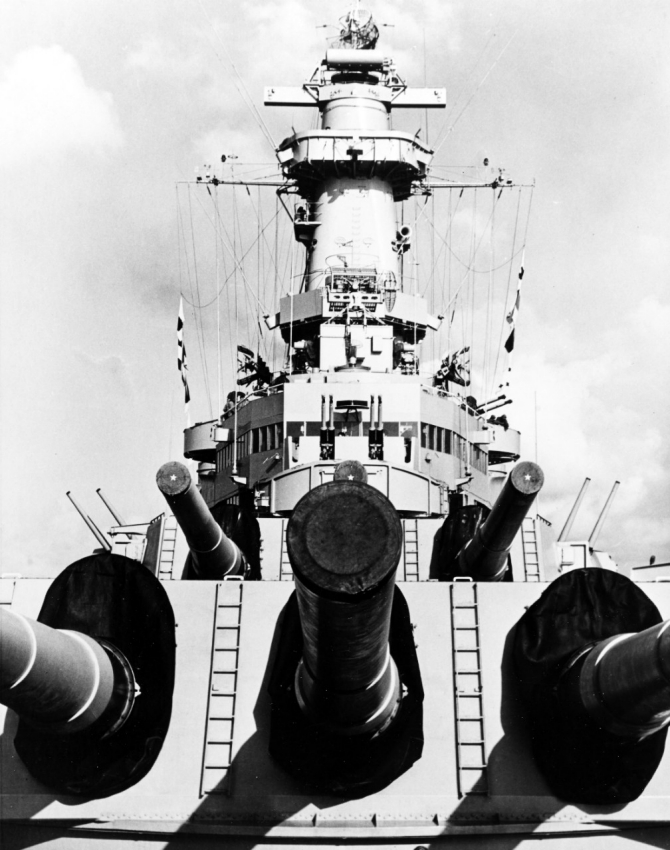
Relieved as flagship of the Seventh Fleet on 1 April by sister ship Iowa (BB-61), Wisconsin departed Yokosuka, bound for the United States. En route home, she touched briefly at Guam, where she took part in the successful test of the Navy's largest floating drydock on 4 and 5 April, marking the first time that an Iowa-class battleship had ever utilized that type of facility. She continued her homeward-bound voyage, via Pearl Harbor, and arrived at Long Beach, Calif., on 19 April. She then sailed for the east coast; her destination: Norfolk.
Early in June 1952, Wisconsin resumed her role as a training ship, taking midshipmen to Greenock, Scotland; Brest, France; and Guantanamo Bay, Cuba, before returning to Norfolk. She departed Hampton Roads on 25 August and participated in a North Atlantic Treaty Organization (NATO) exercise, Operation Mainbrace which commenced at Greenock and extended as far north as Oslo, Norway. After returning to Norfolk, Wisconsin underwent an overhaul in the naval shipyard there. She then engaged in local training evolutions until 11 February 1953, when she sailed for Cuban waters for refresher training. She visited Newport, R.I., and New York City before returning to Norfolk late in April.
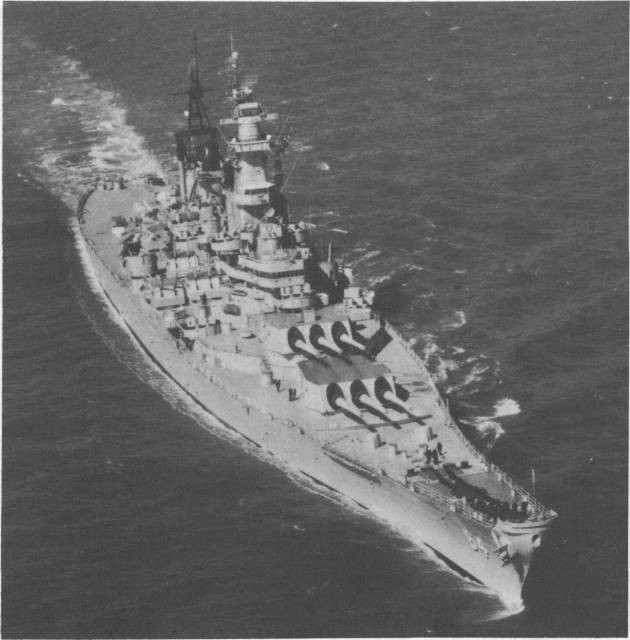
Following another midshipman's training cruise to Rio de Janeiro, Brazil; Port-of-Spain, Trinidad; and Guantanamo Bay, Wisconsin put into the Norfolk Naval Shipyard on 4 August 1953 for a brief overhaul. A little over a month later, upon conclusion of that period of repairs and alterations, the battleship departed Norfolk on 9 September, bound for the Far East.
Sailing via the Panama Canal to Japan, Wisconsin relieved New Jersey (BB-62) as Seventh Fleet flagship on 12 October. During the months that followed, Wisconsin visited the Japanese ports of Kobe, Sasebo, Yokosuka, Otaru, and Nagasaki. She spent Christmas at Hong Kong and was ultimately relieved of flagship duties on 1 April 1954 and returned to the United States soon thereafter, reaching Norfolk, via Long Beach and the Panama Canal, on 4 May 1954.
Entering the Norfolk Naval Shipyard on 11 June 1954, Wisconsin underwent a brief overhaul and commenced a midshipman training cruise on 12 July. After revisiting Greenock, Brest, and Guantanamo Bay, the ship returned to the Norfolk Naval Shipyard for repairs. Shortly thereafter, Wisconsin participated in Atlantic Fleet exercises as flagship for Commander, Second Fleet. Departing Norfolk in January 1955, Wisconsin took part in Operation Springboard, during which time she visited Port-au-Prince, Haiti. Then, upon returning to Norfolk, the battleship conducted another midshipman's cruise that summer, visiting Edinburgh; Copenhagen, Denmark; and Guantanamo Bay before returning to the United States.
Upon completion of a major overhaul at the New York Naval Shipyard, Wisconsin headed south for refresher training in the Caribbean, later taking part in another Springboard exercise. During that cruise, she again visited Port-au-Prince and added Tampico, Mexico, and Cartagena, Colombia, to her list of ports of call. She returned to Norfolk on the last day of March 1956 for local operations.
Throughout April and into May 1956, Wisconsin operated locally off the Virginia capes. On 6 May, the battleship collided with the escort destroyer Eaton (DDE-510) in a heavy fog. Wisconsin put into Norfolk with extensive damage to her bow and, one week later, entered dry dock at the Norfolk Naval Shipyard. A novel expedient speeded her repairs and enabled the ship to carry out her scheduled midshipman training cruise that summer. A 120-ton, 68-foot long section of the bow of the uncompleted battleship Kentucky was transported, by barge, in one section, from the Newport News Shipbuilding & Dry Dock Corp., Newport News, Va., across Hampton Roads to the Norfolk Naval Shipyard. Working round-the-clock, Wisconsin’s ship’s force and shipyard workers completed the operation that grafted the new bow on the old battleship in a mere 16 days. On 28 June 1956, the ship was ready for sea.
Embarking 700 NROTC midshipmen, representing 52 colleges and universities throughout the United States, Wisconsin departed Norfolk on 9 July 1956, bound for Spain. Reaching Barcelona on the 20th, the battleship next called at Greenock and Guantanamo Bay before returning to Norfolk on the last day of August. That autumn, Wisconsin participated in Atlantic Fleet exercises off the coast of the Carolinas, returning to port on 8 November 1956. Entering the Norfolk Naval Shipyard a week later, the battleship underwent major repairs that were not finished until 2 January 1957.
After local operations off the Virginia capes from 3-4 January and from 9-11 January 1957, Wisconsin departed Norfolk on 15 January, reporting to Commander, Fleet Training Group, at Guantanamo Bay. Breaking the two-starred flag of Rear Adm. Henry Crommelin, Commander, BatDiv 2, Wisconsin served as Admiral Crommelin's flagship during the ensuing shore bombardment practices and other exercises held off the isle of Culebra, Puerto Rico, from 2-4 February. Sailing for Norfolk upon completion of the training period, the battleship arrived on 7 February.
The warship conducted a brief period of local operations off Norfolk before she sailed, on 27 March 1957, for the Mediterranean. Reaching Gibraltar on 5 April, she pushed on that day to rendezvous with TF 60 in the Aegean Sea. She then proceeded with that force to Xeros Bay, Turkey, arriving there on 11 April for NATO Exercise Red Pivot.
Departing Xeros Bay on 14 April 1957, she arrived at Naples four days later. After a week's visit, during which she was visited by Italian dignitaries, Wisconsin conducted exercises in the eastern Mediterranean. In the course of those operational training evolutions, she rescued a pilot and crewman who survived the crash of a plane from the carrier Forrestal (CVA-59). Two days later, Vice Adm. Charles R. Brown, Commander, Sixth Fleet, came on board for an official visit by high-line and departed via the same method that day. Wisconsin reached Valencia, Spain, on 10 May and, three days later, entertained prominent civilian and military officials of the city.
Departing Valencia on the 17th, Wisconsin reached Norfolk on 27 May 1957. On that day, Rear Adm. Lewis S. Parks relieved Rear Adm. Crommelin as Commander, BatDiv 2. Departing Norfolk on 19 June, the battleship, over the ensuing weeks, conducted a midshipman training cruise through the Panama Canal to South American waters. She transited the canal on 26 June; crossed the equator on the following day; and reached Valparaiso, Chile, on 3 July. Eight days later, the battleship headed back to the Panama Canal and the Atlantic.
After exercises at Guantanamo Bay and off Culebra, Wisconsin reached Norfolk on 5 August 1957 and conducted local operations that lasted into September. She then participated in NATO exercises which took her across the North Atlantic to the British Isles. She arrived in the Clyde on 14 September and subsequently visited Brest, France, before returning to Norfolk on 22 October.
Wisconsin's days as an active fleet unit were numbered, and she prepared to make her last cruise. On 4 November 1957, she departed Norfolk with a large group of prominent guests on board. Reaching New York City on 6 November, the battleship disembarked her guests and, on the 8 November, headed for Bayonne, N.J., to commence pre-inactivation overhaul.
Placed out of commission at Bayonne on 8 March 1958, Wisconsin joined the "Mothball Fleet" there, leaving the United States Navy without an active battleship for the first time since 1895. Subsequently taken to the Philadelphia Naval Shipyard, Wisconsin remained there until she was moved across the yard to another pier in February 1986 for preliminary work prior to reactivation. On 1 August Wisconsin was reactivated and she was towed to Avondale Shipyard in New Orleans, La. for dry dock work. In January 1987 she was then towed to Ingalls Shipyard in Pascagoula, Miss. for a complete modernization and reactivation including the installation of four MK 141 quad cell launchers for 16 AGM-84 Harpoon anti-ship missiles, eight Armored Box Launcher (ABL) mounts for 32 BGM-109 Tomahawk missiles, and a quartet of the Navy's Phalanx Close in Weapon System (CIWS) 20 millimeter Gatling guns for defense against enemy anti-ship missiles and aircraft. Wisconsin also received eight RQ-2 Pioneer Unmanned Aerial Vehicles, which are remotely controlled drones used to spot for her 16" guns.
Wisconsin was recommissioned at Pascagoula on 22 October 1988, Capt. Jerry M. Blesch, commanding. She was subsequently homeported at Naval Station Norfolk. In December Wisconsin began a period of holiday leave and upkeep that was completed on 3 January 1989. On 4 January, she departed Norfolk en route to Pascagoula, where she arrived on 8 January, remaining there fitting out and conducting Combat Systems Qualification testing (CSSQT) until 31 January. On 2 February, she got underway to visit Mobile, Ala. for a Mardi Gras visit, after which she returned to Pascagoula. From 8-17 February she remained at Pascagoula undergoing a Restricted Availability. Departing Pascagoula on 17 February, Wisconsin conducted training in the Gulf of Mexico, western Atlantic, and Virginia capes Operating Area. She returned to Norfolk on 25 February and remained there for upkeep until 28 March. While at Norfolk the ship also conducted in-port CSSQT (6-23 March) punctuated with an ammunition onload (13-18 March) at Hampton Roads, Va. On 28 March she got underway for CSSQT in the western Atlantic which continued until 8 April, then moved on to Puerto Rican waters and Vieques Island where she conducted NGFS training, upon completion of which (14 April) she made a port call at St. Thomas where she remained until 17 April. Returning to Norfolk from 17-22 April, she conducted her Engineering Mobile Training Team (MTT) visit while underway. During that transit Wisconsin also conducted an underway replenishment from Neosho (AO-143) on 20 April. Following in-port upkeep at Norfolk (22 April-8 June), the battleship then offloaded ammunition (8-12 June) before transiting to Philadelphia Navy Yard. Arriving on 14 June, Wisconsin underwent a restricted availability with drydocking until 18 August. During that time, the crew undertook Tomahawk and Harpoon Material Certification (15-27 June).
Underway on 18 August 1989, Wisconsin returned to Norfolk two days later, and following her arrival conducted upkeep. Clearing Hampton Roads on 25 August for her new homeport of Ingleside, Texas, she arrived there on 31 August. She remained there conducting a new homeport visit until 5 September when she got underway for Pascagoula, arriving on 7 September. While in Pascagoula the ship underwent her Post Shakedown Availability until 12 December. During this time, Wisconsin conducted sea trials in the Gulf of Mexico (5-7 December). Having left Pascagoula on 12 December, the ship conducted her Training Readiness Evaluation en route to Norfolk where she arrived on the 17th. The remainder of 1989 was spent conducting upkeep and holiday leave.
On 2 August 1990, Iraqi forces invaded the emirate of Kuwait and Saddam Hussein, the President of Iraq, announced a few days later that it was annexed as the 19th province of Iraq. In addition to condemning the invasion as a violation of international law, the United States responded by deploying military forces to the Persian Gulf. Wisconsin departed Norfolk on 7 August 1990, beginning the deployment that eventually saw an end to Iraqi aggression and the restoration of Kuwaiti sovereignty. Wisconsin made the 8,500-mile transit to the Persian Gulf at 25 knots, arriving on station, ready for combat, just 16 days after departure. Having recommissioned that magnificent warship, trained her and brought her safely to the Persian Gulf, the recommissioning commanding officer, Capt. Jerry M. Blesch, was relieved by Capt. David S. Bill III at Sitrah Anchorage off Bahrain Island on 28 September 1990.
During Operation Desert Shield, Wisconsin illustrated the flexibility and utility of America's modernized battleships with a fuel capacity of more than two million gallons, Wisconsin resurrected her World War II role as an "armored oiler," providing over one million gallons of fuel to more than a dozen different U.S. and allied surface combatants. She also provided technical assistance, medical and dental services, electronics repair, motor rewind, and machine shop support for both coalition and U.S. forces, thus easing the burden on dedicated repair and logistics ships. Additionally, throughout her first four months on station, Wisconsin was actively involved in the detailed planning and liaison efforts, both ashore and afloat, which would put together the procedures and plans to support naval operations during hostilities. Wisconsin drove the planning of Tomahawk and gunfire strike, naval gunfire support, Kuwait amphibious precursor, and remotely piloted vehicle operations. All were coordinated through Wisconsin's leadership, while the battleship provided on-station deterrence against further Iraqi aggression, carried out responsibilities as the Persian Gulf force "over the horizon targeting coordinator" at sea and in port, and honed her warfighting skills.
On 24 December 1990 Wisconsin took time off from her routine of drills, gunnery practice, and training evolutions to conduct the ”Persian Gulf Sports Festival” on her flight deck. While anchored off Bahrain, athletes from six ships and one shore command competed in boxing, wrestling, and weight-lifting competitions, as well as a talent show. Gold, silver and bronze medals were awarded to winners with national media coverage of the event. Reinforced by the arrival of sister ship Missouri in early January 1991, Wisconsin got underway from Bahrain on 13 January in anticipation of the start of offensive operations against Iraq, Operation Desert Storm.
Early on the morning of 17 January 1991, Wisconsin, acting as Tomahawk Strike Warfare Commander for the Persian Gulf, directed the sequence of Tomahawk launches that initiated the opening of hostilities in Operation Desert Storm. Paul F. Foster (DD-964) fired the first Tomahawk missile from the Persian Gulf at 0140:20. Her shot was quickly followed by five other ships in the Persian Gulf Strike Force. Wisconsin's eight missiles were included in the total of 47 Tomahawks fired in the initial volley. During the next two days Wisconsin fired a total of 24 Tomahawk land attack missiles, while continuing to coordinate the successful launch of 213 of 214 assigned Persian Gulf Tomahawk strike missions. The battleship also assumed responsibilities as the local anti-surface warfare coordinator for the Northern Persian Gulf Surface Action Group.
When the focus of operations shifted to the aerial bombing campaign, Wisconsin served as a vital logistics and personnel transportation hub for the central Gulf. By receiving passengers, mail and cargo (PMC) bound for all ships in the northern Persian Gulf from shore-based logistics facilities, Wisconsin greatly reduced the burden on the logistics support infrastructure. Altogether Wisconsin transferred over 40,000 lbs. of mail, 140 personnel and 20,000 lbs. of cargo. Wisconsin relieved Missouri "on the gunline" near the Kuwaiti border on 6 February. Wisconsin's first fire mission was called in by a USMC OV-10 Bronco observation aircraft shortly after the battleship's arrival on station. Wisconsin fired 11 rounds and destroyed an Iraqi artillery battery located in southern Kuwait.
On the following morning, 7 February 1991, Wisconsin fired 29 projectiles at an Iraqi communications facility, heavily damaging the site. Spotting services were provided by Wisconsin's organic RQ-2 remotely piloted vehicle (RPV), equipped with infrared (night) and daylight television cameras whose signals were relayed to the battleship at ranges over 60 miles. Later that evening, Wisconsin was tasked to destroy Iraqi Special Forces boats at the Khawr al-Mufattah marina on the Kuwaiti coast. Using the RPV, Wisconsin delivered 50 one-ton, high-explosive projectiles into the target area, destroying or severely damaging several piers and over fifteen small boats. In subsequent pre-arranged fire missions that evening, Wisconsin delivered nineteen rounds on suspected artillery batteries and command posts.
On 8 February 1991, Wisconsin completed her first gunfire support operations off Khafji, Saudi Arabia firing against artillery batteries, infantry bunkers, and an Iraqi mechanized unit in direct support of USMC ground operations. Twenty-nine rounds were fired during eight separate fire missions. Additionally, the night reconnaissance capability of the RPV was used to locate targets and track enemy movements. In particular, RPV's conducted surveillance of the Kuwaiti coast and interior, Kuwait City, and Faylaka Island providing intelligence for planning the follow-on ground offensive, Special Forces raids, and amphibious operations. Throughout that period Wisconsin operated in restricted, mine-infested waters within range of enemy Silkworm missiles.
Between 9-20 February 1991 Wisconsin returned to the central Persian Gulf, rearmed, replenished, refueled, and resumed her logistics role. On 19 February, Wisconsin hosted a visit by Senator John Warner of Virginia on his 64th birthday. Congratulating gunner's mates after a firepower demonstration, the senator, who had visited Wisconsin while serving in the Korean War, remarked: "That was the biggest candle anyone has ever lit for my birthday."
Returning to the gunline off Khafji on 21 February 1991, Wisconsin fired 50 rounds into an Iraqi command complex which the RPV had observed being resupplied by truck. Over ten buildings in the target area, which housed Iraqi troops and communications facilities, were completely destroyed or heavily damaged. On 23 February, Wisconsin fired 94 rounds at Iraqi forces, devastating several infantry positions and harassing artillery, command posts, and surface-to-air missile (SAM) sites in preparation for the ground war which was to start the following morning. On 24 and 25 February as the push north into Kuwait began, Wisconsin fired 23 rounds during two call-for-fire missions for coalition forces, quickly suppressing resistance at two Iraqi bunker complexes, and paving the way for the continued advance towards Kuwait City. An elated Saudi marine commander praised Wisconsin for her accurate fire, and commented over the radio, ''I wish we had a battleship in our navy."
As the ground advance progressed, Wisconsin repositioned, completing a 20-hour overnight transit through mined waters, to arrive off Kuwait City on the morning of 26 February 1991. While underway, Wisconsin provided a vital communications relay between marine forces, Air Naval Gunfire Liaison Company (ANGLICO) units ashore, and Missouri. Anchored in the forward part of the cleared fire support area, just 11 miles off the coast of Kuwait and well within Silkworm missile range, Wisconsin flew continuous RPV missions in support of the advancing coalition troops and fired the last naval gunfire fire support mission of the war.
Throughout the next seven days, Wisconsin remained on station, while coalition ground forces entered and secured Kuwait City. On 27 February 1991 an RPV flight detected two military boats fleeing Faylaka Island. Attack aircraft were called in to destroy the boats, which reportedly were carrying escaping members of the Iraqi secret police. Another RPV flight over Faylaka Island on 1 March observed hundreds of Iraqis waving white flags, the first recorded instance of surrender to an unmanned aircraft. Wisconsin's RPV continued to gather intelligence on Faylaka's defenses during 2-3 March prior to the evacuation of the Iraqi POWs, while the battleship stood by, ready to provide gunfire support if required. Wisconsin was released from the northern Persian Gulf on 4 March to begin preparations for her trip home, returning to Norfolk on 28 March.
During the eight months Wisconsin was deployed to the Persian Gulf, the battleship participated in every phase of Operations Desert Shield and Desert Storm. While under the constant threat of enemy missile or air attack, Wisconsin fired 24 Tomahawk land-attack missiles, fired 528 16-inch rounds in 36 different naval gunfire support missions, 881 5-inch rounds, and 5,200 20mm CIWS rounds. In addition she flew 348 RPV hours, recorded 661 safe helicopter landings, steamed 46,000 nautical miles, most of which was in the hazardous and restricted waters of the Persian Gulf waters, without a serious material casualty or personnel injury. From putting ordnance on target, refueling the task force, providing communications and logistics support, Wisconsin played a vital role in restoring the sovereignty of Kuwait.
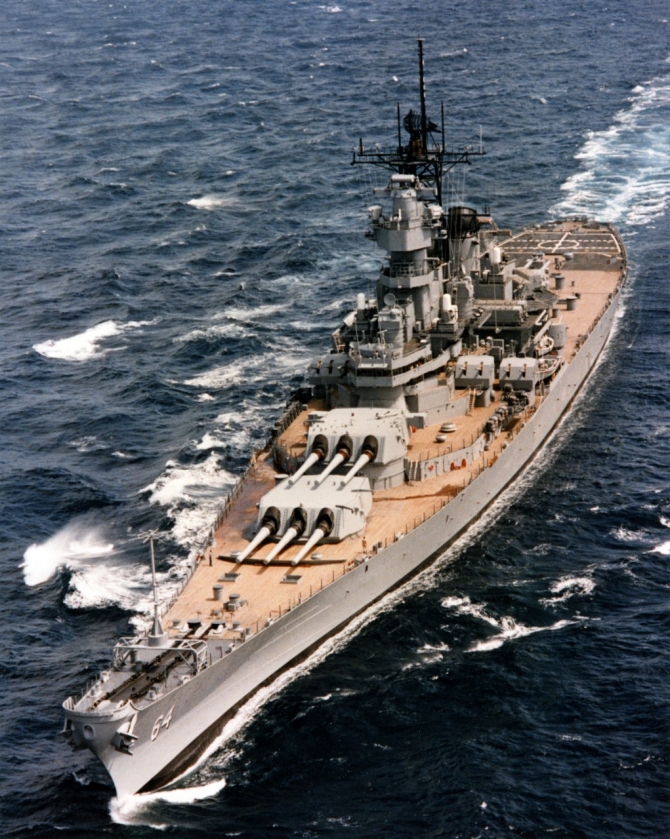
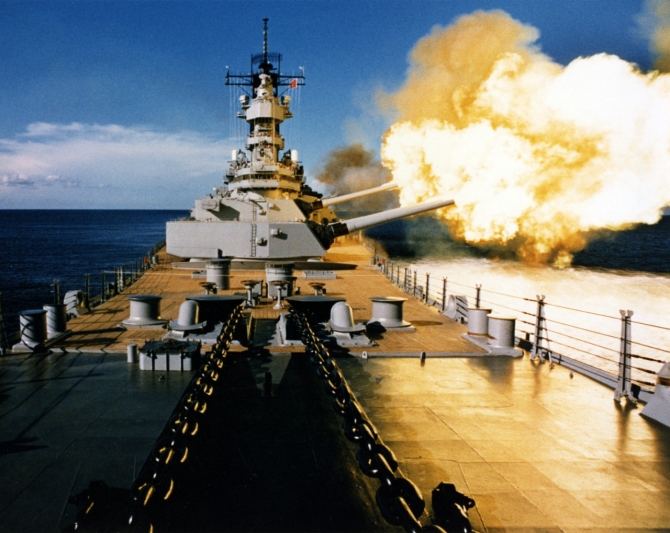
Having served with distinction in three wars, Wisconsin was decommissioned at Norfolk Naval Station, Pier 11, on 30 September 1991. The ship was stricken from the Naval Vessel Register on 17 March 2006. On 14 December 2009, the Navy officially transferred the battleship to the city of Norfolk. Wisconsin was listed on the National Register of Historic Places on 28 March 2012 and she is berthed adjacent to the Nauticus National Maritime Center in Norfolk.
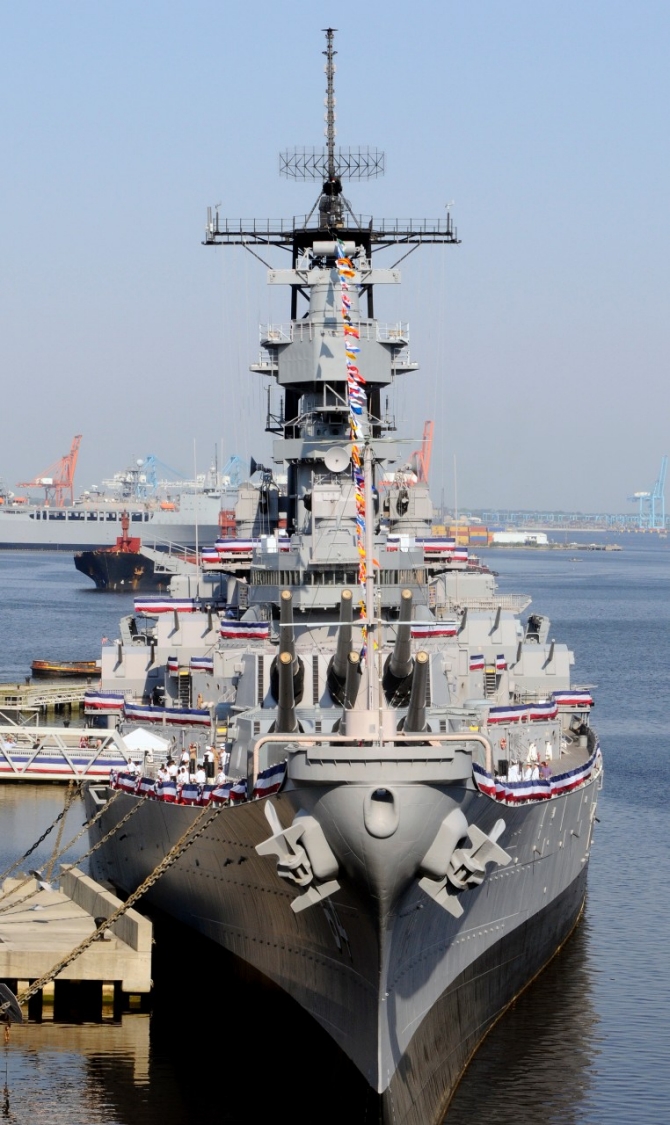
Wisconsin earned five battle stars for her World War II service, and one for Korea. In addition, for her participation in Operation Desert Storm, she received the Combat Action Ribbon (17 January-28 February 1991), the Navy Unit Commendation I17 January-28 February 1991) and the Southwest Area Service Medal (18 August 1990-13 March 1991).
Commanding Officers Dates Assumed Command
Capt. Earl E. Stone 16 April 1944
Capt. John W. Roper 20 February 1945
Capt. Clark L. Green 18 December 1945
Capt. John M. Higgins 11 March 1947
Capt. Thomas Burrowes 3 March 1951
Capt. Henry C. Bruton 22 February 1952
Capt. Robert J. Foley 24 September 1952
Capt. Michael F. D. Flaherty 9 September 1953
Capt. Goldsborough S. Patrick 11 June 1954
Capt. Frederic S. Keeler 3 September 1955
Capt. John O. Miner 1 September 1956
Capt. Jerry M. Blesch 22 October 1988
Capt. David S. Bill III 28 September 1990
Capt. Coenraad van der Schroeff 27 April 1991
Entry modified and amended by:
Christopher B. Havern Sr.
7 March 2016
Updated by Robert J. Cressman
30 October 2020


